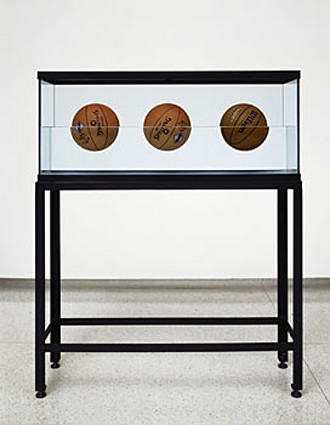In gearing up for my TA duties for "Intro to Art Theory," I'm making an attempt to see things from the student's perspective... from the perspective of those who may not be predisposed to admire poop-making machines (see Wim Delvoye) or painfully minimal descriptions of nothing (see Martin Creed) like I am. Being in art school, it's easy to forget that the majority of the viewing public just doesn't "get it." Without an art-historical and theoretical context, much of modern and contemporary art may seem unreachable to the masses who have their their own ideas and preconceived notions of what IS and is NOT "Art."
Below, I've identified a number of categories that tend to be a bit more difficult to digest... especially for a "non-art" audience. The distinctions are not cut and dry, but often seem to blend into one another. They are...
abstract: does not attempt to represent external, recognizable reality but seeks to achieve its effect using shapes, forms, colors, and textures
 |
| Cy Twombly, Untitled VII from Bacchus Series, 2005. |
minimal: set out to expose the essence, essentials or identity of a subject through eliminating all non-essential forms, features, or concepts
 |
| Robert Morris, installation in the Green Gallery, New York, 1964. Seven geometric plywood structures painted grey. |
conceptual: the idea presented by the artist is considered more important than the finished product, if any exists
 |
| Robert Rauschenberg, Erased de Kooning, 1953 (more HERE) |
readymade: created from undisguised, but often modified, objects that are not normally considered art, often because they already have a non-art function
banal: comment on or acknowledgement of that which is so lacking in originality as to be obvious and boring (often overlaps with readymade)
 |
| Jeff Koons, Three Ball Total Equilibrium Tank, 1985 |
process-based: the process of making is not hidden but remains a prominent aspect of the completed work so that a part or even the whole of its subject is the making of the work
 |
| Richard Serra, Splashing, 1968, molten lead splashed into corner and solidified |
performative: the medium is the artist's own body and the artwork takes the form of actions performed by the artist
 |
| Chris Burden, Shoot, 1971, artist shot in the arm in gallery |
relational: takes as its theoretical and practical point of departure the whole of human relations and their social context, rather than an independent and private space
 |
| Félix González-Torres, untitled (Portrait of Ross in LA), 1991, viewers invited to take a piece of candy |
I recently came across this BBC series about Goldsmiths (a famous art school in London) called "But is it Art?" It's made up of two 1-hr episodes (which are both on YouTube). The first follows several MFA students in the weeks leading up to their thesis shows, and the second tracks them in the months following their graduation. I quite enjoyed it... but I can understand why it might elicit some giggles and rolling of eyes. Art school is a curious place... more on that to come...

No comments:
Post a Comment